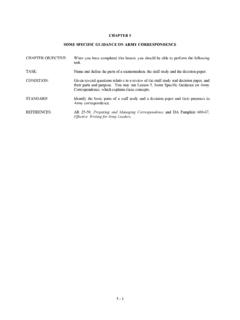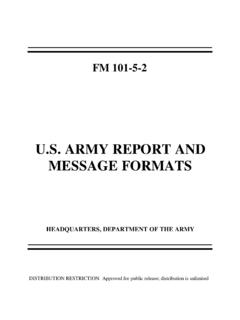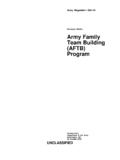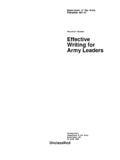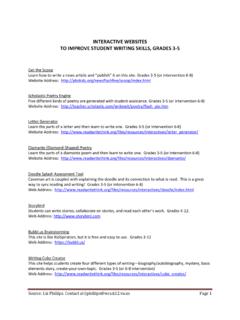Transcription of CHAPTER 3 PRINCIPLES OF ARMY WRITING STYLE
1 CHAPTER 3 PRINCIPLES OF army WRITING STYLE CHAPTER OBJECTIVE: When you have completed this lesson, you should be able to perform the following tasks. TASK: Apply the PRINCIPLES of army WRITING to improve your WRITING effectiveness. CONDITION: You will be given several questions regarding the rules of army WRITING . You may use the instructional content of this lesson. STANDARD: You must accurately identify the PRINCIPLES of army WRITING and how they apply to WRITING effectively. REFERENCES: AR 25-50, Preparing and Managing Correspondence and DA Pamphlet 600-67, Effective WRITING for army Leaders.
2 3 - 1 CHAPTER 3 PRINCIPLES OF army WRITING STYLE 1. INTRODUCTION. At various times soldiers will have to communicate their intention through WRITING . Putting our thoughts on paper is important, but just as important is to ensure that what we have written clearly communicates our intentions. Our understanding of "how to" organize our thoughts into coherent sentences and paragraphs can help ensure that we communicate clearly. The objective of this lesson, then, is to help you as a writer sharpen your understanding of the army WRITING STYLE by briefly reviewing the structure and function of word groups (phrases, clauses, sentences, and paragraphs) to assist you in WRITING effectively.
3 2. PRINCIPLES OF EFFECTIVE STYLE . a. Accuracy. Your work should represent only essential and accurate facts free of bias or distortion. b. Brevity and completeness. You must keep to essentials. Your WRITING should be brief and to the point. To cover a subject completely, while keeping the length of the paper to the absolute minimum requires careful analysis and probably several revisions. If necessary, attach explanatory facts and figures as annexes. The shorter your paper, the less your chance for error. On the other hand, never sacrifice clarity to gain brevity.
4 C. Clarity. You must make a special effort to keep your WRITING clear and fully understandable. Your readers must be certain of your intent. Select words and phrases that express your exact meaning and can only have one interpretation. Using familiar, precise words contributes to clarity in WRITING . d. Coherence. Coherence is the logical development and arrangement of a subject. You can achieve coherence by first thinking the subject through and seeing it as a whole, then arranging the various parts logically and harmoniously. When WRITING on a complex subject, use an outline to achieve coherence.
5 E. Unity. Your WRITING must adhere to a single idea. You should apply this principle not only to each sentence and paragraph but also to your entire paper. If you have more than one subject to discuss, prepare a separate paper on each subject. 3. PUT YOUR BOTTOM LINE UP FRONT. a. The purpose statement. Open with a short, clear purpose sentence. The purpose statement is not the same as the bottom line. It only tells the reader what to expect when reading the paper. A purpose statement does not tell the reader the conclusion(s) the writer draws. b. Thesis.
6 The bottom line or thesis statement tells your reader what it is you consider important. Put the recommendation, conclusion, or most important information (the main point) next. (Some writers combine the purpose and the main point.) The army standard for WRITING requires putting the main point up front and using the active voice. It is best to capture your bottom line in a single sentence that is clear and easy to understand. Being able to state your thesis in a single sentence indicates that you have a good understanding of your subject.
7 After you have stated your bottom line and explained it in the first paragraph, you are free to support your thesis. For example: Purpose: It is the purpose of this paper to discuss creating a fair and democratic electoral system for Haiti. 3 - 2 Thesis: The proposed changes to the Haitian electoral system will ensure fair and democratic elections. c. Major parts. Introduce the major parts right after your thesis statement. This tells the reader how you will develop support for your position. 4.
8 CLEAR AND CONCISE SENTENCES. A sentence consists of an arrangement of words to transmit a thought. The words you select, their clarity, conciseness, and how you arrange them directly affects whether your audience will understand your message. A clear and logical sentence is one that has both coherence and unity. A concise sentence expresses an idea with as few words as possible. Your written (and spoken) communication must be clear, direct, and understandable. The following guidelines will help you communicate clearly.
9 A. Choose effective words and phrases. The words and phrases you choose directly affects the clarity and conciseness of each sentence. As you select the words and phrases for each sentence ask yourself, "Do these words and phrases effectively say what I want? Would my reader understand them?" If you can't answer yes, then you need to re-examine what you are trying to say. (1) Use concrete words. Concrete words are easy to understand because they relate to the five senses. For example, the term M16A2 is meaningful to a military audience because it represents an object that you can see, feel, and use.
10 Abstract words, on the other hand, are hard to understand because they fail to recall experiences of the five senses. Some language experts describe words in terms of an abstraction ladder. (a) The lower rungs of the ladder represent objects the reader can readily identify. They are concrete words. (b) As you go up the ladder, each word becomes more abstract than the one below. At the same time, the meaning becomes vague and open to debate. Such a ladder might look like this: MATERIALINSTRUMENT OF WARWEAPONRIFLEM16A2 RIFLEABSTRACTCONCRETE Figure 3 1.
